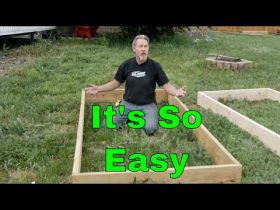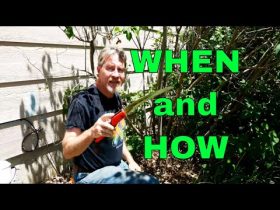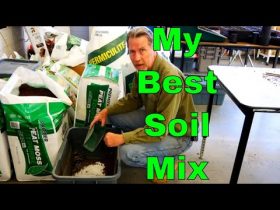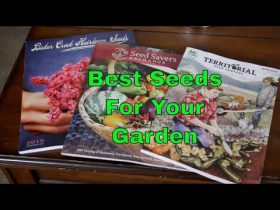If you’re a new gardener and you’ve made some mistakes, maybe last year’s garden wasn’t the best and you really are a little discouraged, then this article is for you. Kevin Espiritu here from Epic Gardening where it’s my goal to help you grow a greener thumb. I think we had something like 16 to 18 million new gardeners in 2020, with all signs pointing to even more in 2021.
And with new gardening, I remember my first time, I mean, I grew hydroponic cucumbers and they tasted absolutely awful. I think my brother actually said that he almost threw up when he ate them. And so that’s not a good sign. It wasn’t the best first crop for me either. Which is why, in today’s article, I’m going to go over maybe nine or 10 of the most common and devastating gardening mistakes that will prevent you from having Epic harvests.
So you know what to do, cultivate that Like button and I will personally give you a money back guarantee that you will not have any gardening mistakes. By the way, this article is free. So I’m sorry, the money back guarantee isn’t really worth a whole lot. But let’s get into the article. Mistake number one is putting your garden in an inconvenient location.
It’s very similar to working out. You know, you don’t want to make your gym bag really hard to get to. You want your meals ready to go. I could probably take some advice there. But in the garden, I certainly have mastered this. And that’s because my gardens are easy to access. What you want to do is make it accessible and easy to work in, low friction.
For me actually, in my raised bed garden at least, that means a tall raised bed. Really helps me. I’m quite tall and I don’t want to bend down as much. Save my back. Again, another easy thing to do. But these tiny little things – this really doesn’t even have to do with any gardening practice – fertilizing, watering, transplanting, starting seeds.
It’s just where the garden is in the first place. It’s a huge mistake that people can make when they’re starting out. So make it easy to access and you’ll have a much better time. Mistake number two is planting in an area that doesn’t get enough sun, is not a good location for planting.
So I was hanging out by my chimney there. This is my north facing wall. So this is oriented north. This one is oriented east to west. And the sun of course rises in the east, sets in the west. So the pattern of my sun here on my property, it comes from about there in the winter and ends right about there.
What does that mean? It doesn’t get high enough right now to crest over this wall and it also doesn’t make it anywhere over there. And so what does that mean? In this bed I can’t really plant much that’s going to need a ton of sun. And so a huge mistake you can make, as a beginner gardener, is planting things that don’t match to the sun and light availability of an area.
The best way to do that is observation. Maybe 8:00 AM, 12:00 PM, 4:00 PM – go out and just kind of see where the shadows fall. And just remember that this is actually going to change based on the time of year. So a really good resource I’ll leave down in the description. It’ll allow you to drag over the months and it’ll show you how the sun will fall over your property.
You can type in your exact address. But again, remember planting is the most important time. If you make a mistake in planting, you’ve locked that plant in stone. Unless you’re growing in a container, which is another great way to mitigate some of these mistakes. But please remember, do not plant in an area that does not have enough sun for the plant you’re trying to grow.
Mistake number three is planting too far from a water source. So I want to show you what I’ve had to do. I don’t have irrigation set up here at the Epic Garden. I actually have ONE outlet here for water on the side of my house that’s really inconveniently placed. It’s in the middle of my house between the front and the back yard.
And so I’ve used a hose splitter here and then I’ve split that many times over. Of course, I’m going to get irrigation. But the reason why you don’t want to do this is because again, it’s one of those laziness things. If you’re going to have to lug water over, you might just decide not to do it that day.
And then the day gets too hot. The plants die and you’re in a big world of hurt. And you’ve again, killed some plants. You don’t want to do that. So let me show you what I’ve done. Again, this is not the best solution. I’m still getting irrigation set up here, but hey, if it works, it works.
If it lets me access water then I’m happy. Like I mentioned, the first thing I’ve done is split this. So we go to the front yard with one of the hoses. Now what you could do here is you could just use a standard hose. But I’ve put this into a Hoselink, which is a hose bib that has a retractable reel right here.
So this one can extend out about 82 feet and it can go just about anywhere in this front yard garden. So I’ve got perfect access in the front yard. The second hose comes through right here. We’re going to wind around the back. Again, if it works, it works. It’s not the most clean setup, but we’ve gone to another hose bib right here with the Hoselink.
And I can access everything in this little temporary orchard as well as all of the back garden back there. Mistake number four, one I admit I have made quite a bit, especially in my first few years of gardening is not respecting the power of the mulch. We must respect the power of the mulch. This is just some bare potting mix right here, recently amended.
And sure, yeah, I could plant right into this and I’m sure I would be okay. But I can reduce my watering needs, protect the soil, protect any sort of splash-up disease type of issues with the use of some kind of mulch. Now, if you’ve been watching this channel a while, you know I’m obsessed with this shredded straw mulch from a company called GardenStraw.
It’s not available here in the U.S. I should have it available on my store sometime around April 2021, but don’t let the fact that you can’t get the exact straw that I use prevent you from using mulch. There’s plenty of different things that you can use. You can of course, source straw in your own area.
You can use grass clippings. You can use shredded leaves, fall leaves if you’re in an area that gets a lot of leaf drop. I’m jealous, I don’t. And fall leaves are a fantastic cover. Now the couple of things that you want to keep in mind with mulch. You want to make sure that you lay down a thick enough layer.
I would say at least two inches or so if possible. And just because I’m in a raised bed right here doesn’t mean that you should only mulch a raised bed. You should mulch your inground plantings and you should also mulch even smaller containers like some grow bags or just some patio style containers with something like a straw.
You can do it. It is so, so beneficial. It’s going to reduce the amount that you need to water. It’s going to protect the surface of the soil and there’s just a million and one different ways that you can do it. I’ve got a whole article on cheap sources of mulch that you should check out.
But remember to mulch your garden. Mistake number five is not preparing the soil, not taking the time to prepare the soil before you plant. Now, if you’re growing in a raised bed or a container that just means selecting the right container mix, which I’ll do a article on this spring. But let’s just take this bed for example.
This is the no dig bed that I did in collaboration with Charles Dowding. And many of you who watched that article, you’ll know that even during the making of that article I was critiquing my own process as compared to Charles, who is the master of the no dig garden bed. And so I actually ended up making some changes to this bed based on some of the mistakes I thought I made and then later knew I made in the soil preparation.
So what I did here is I added a bunch of pumice to this to lighten it up. I was noticing that I was getting a little stunted growth here in the no dig bed because I think the compost mixture was just holding way too much water. Just way too much. And so that was a soil preparation mistake that if I didn’t know that, and I had a couple of years of gardening under my belt, I would’ve just let that be.
And then these cabbage plants would have just sat here doing nothing for three, four months because they have no ability to actually take in nutrients and grow. So soil preparation. Now, if you’re growing inground, the first thing I recommend wholeheartedly, it’s a little annoying to do, is to get a soil test.
You have to do this to know what type of soil you’re working with. I have a article on some DIY soil tests you can do, but nothing’s going to beat hitting up your local nursery and saying, hey, can you put me in touch with someone who can do a soil test? And they’ll give you not only the composition of your soil, but the nutritive qualities of your soil, how much organic matter is in the soil.
Are you deficient in any particular macro-nutrient as well as, if you want, it’s probably a little bit of extra money, you can get a heavy metal and salt report as well. Just to see if there’s anything really funky going on with your soil, especially when you’re planting inground in a new space because you just don’t know what happened in the decades before you lived in this place.
So soil preparation is a massive, massive mistake that you can avoid, of course, by doing the preparation. Mistakes number six and seven, I’m going to give you a two-parter here in this exact bed, is planting things that you don’t like to eat. So here I have some beets and some kale. Fortunately, I have learned to like beets a lot more.
I like to roast them up now, but kale I’ve always liked. So these are two things that I enjoy eating. Now I think what a lot of beginners will do is they might Google easiest plants to grow, beginner gardening suggestions, things like that. And then they’ll just grow whatever that says without any regard for if you like to eat that plant.
Now, look, I love growing weird plants, unique plants, plants that maybe I don’t even like to eat. So I do break this rule for the love of the grow, for the love of the garden. I want to see something interesting and maybe I’ll just give it to someone else who does like it. But if you’re trying to grow a garden for your family and maybe some friends and of course yourself, pick the things that you actually like to eat.
It’s a little silly to grow something, spend all this time and care, to never harvest it. And even if you do harvest it, not use it, it’s just a little bit of a waste. And number seven, the two-fer here is this is a pretty densely packed bed now that it’s grown in. But I will confess that when things were getting a little busy here at Epic Gardening, I was not spending as much time in this particular bed as I would have wanted to.
And so I have the beets that I direct sowed as well as the kale that I direct sowed. But I usually put a couple of different plants in per hole, a couple of different seeds, just to guarantee that something germinates. Now with beets you don’t need to do that. Beets actually have a compound seed of sorts.
And one what looks like a seed actually has multiple seeds within it. But still you have to thin that out. So you can plant, number one you can plant too densely seed to seed. So you can actually just plant them too close together. But number two, you can not thin them out after they’ve germinated.
So what happened in this particular bed, and of course now it looks really good and I’m really excited, no disease, beautiful structure on the beets and the kale. But what was happening before was I had two, three plants right here, two, three plants right here, two, three, right there. The beets had a couple of different beets all trying to grow next to each other.
And you can do it, they’re just going to be a lot smaller. And that’s what happened. They were just a little bit small, still healthy, but small. And as soon as I thinned them out and gave them some room to breathe, they all blew up in size. So while small space gardening is where I came from, and I love cramming plants in small spaces, you still have to respect there is a certain limit upon which you can cram things in.
Mistake number eight is planting things at the wrong time of year. And I think this hits warmer climate gardeners. More than colder climate gardeners. Because colder climate gardeners, you have a. True beginning and end to your season with your first and last frost dates. And you can plant things a little early, a little late, sure.
But you’re not going to walk outside in the middle of the snow and be like, oh, it’s a great time to grow tomatoes. It’s just not going to happen. Whereas in the higher zones – zones, nine, 10, 11- you can get tricked because it’s really not too cold at any point in time. I would say maybe about 40 degrees Fahrenheit at the absolute lowest in some of these zones.
And so it looks like a time that you could plant just about anything. And so I’ll get questions from people saying, oh, I planted my tomatoes. I planted my, you know, my cucumbers and it’s November. Are they going to do okay? And the answer is technically yes, they’re not going to just immediately die because they know it’s the wrong time to be planted, but they’re not going to thrive.
And so you have to respect the time of year that a plant wants to grow. A summer crop like a tomato or a cucumber of course is going to be best done in late spring through summer. Maybe you can get a second planting of that if you’re in a warmer zone. But you really do have to respect this. And for me, in my warmer zone, I need to respect that there’s certain plants that like it colder that I just can’t grow in the summer.
I’m going to struggle to grow cilantro for example. I’m going to struggle to grow leaf lettuce in full sun in the summer, of course. So right now in spring it’s the perfect time for me to grow some of those crops and either preserve them, although maybe not for the lettuce and the cilantro, but just respect the season and you’ll have a lot more success.
And if you want to know how to do that, what I suggest is watching my article on hardiness zones explained. That will kind of give you the primer on that. And then honestly, ask experienced gardeners, which leads us to our final tip. Our final mistake is to not lean on the experience of others. Gardening is a craft has been passed down generation after generation after generation, all cultures around the world.
And there guaranteed are people alive right now, probably within a mile of you, that know a lot more than you may ever know about gardening. Because they’ve been doing it since they were 15 and they’re 80 now. And so ask them how they do things and lean on them. There’s a couple of different ways you can do this.
Number one, if you have someone in your neighborhood that you know gardens, knock on their door. I guarantee you a gardener is going to want to talk about gardening with you until they’re blue in the face. Number two, you can go to a local county extension office. Just Google your city and then extension office and it should show up.
You can call them, you can email them. They’re literally volunteers, master gardeners that their whole job is to help you succeed in your climate and in your area. And then third, engage with the gardening community. I actually created a Discord server for Epic Gardening. We have about 3000 people in there right now sharing based on where they are in the world.
Based on the type of crop that they’re growing. And it’s basically just like an online chat room. So check it out. I created it. We’re having a lot of fun in there right now! So I highly recommend you check that out. But until next time, hopefully these tips helped you avoid some mistakes in your upcoming season of gardening.
Good luck in the garden. And keep on growing.











Leave a Reply